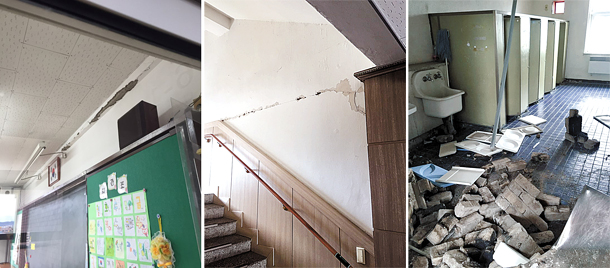Students sit in crumbling classrooms after quake

From left, cracks in classroom walls and in hallways, and shattered ceilings of a bathroom in elementary schools in Gyeongju, North Gyeongsang, show the aftermath of two large earthquakes that hit the city on Sept. 12. While 29 out of 43 elementary schools reported damaged buildings, all of them held classes on Monday. [GONG JEONG-SIK]
At an elementary school on Monday morning in Gyeongju, 235 students sat in classes inside the school building where chunks of cement the size of footballs were missing from the exterior walls and cracks as wide as an adult’s finger were spotted on the walls inside classrooms.
In a building across from them, 60 kindergartners sat in classrooms on the first floor, while the ceiling of the second floor of the building remained collapsed and cement blocks and gravel filled the floor.
Just that morning, an aftershock of 2.1 magnitude hit the city again.
“The classes are being held because officials from the local education office came and said there is nothing wrong with the structure of the roof itself,” said a teacher of another elementary school in Gyeongju, whose roof is entirely made of giwa, or traditional hanok rooftop tiles. Giwa were displaced here and there, an aftermath of the two large earthquakes that hit the city on Sept. 12.
“I don’t think the education authorities know exactly how bad things are down here,” said a teacher in her 40s.
Earthquakes with magnitudes of 5.1 and 5.8 hit Gyeongju on Sept. 12, the largest earthquakes in Korea since 1978, resulting in 48 injuries in North Gyeongsang and some 4,000 incidents of property damage in Gyeongju as of Saturday.
In times of earthquakes or other disasters, school principals can individually decide to temporarily suspend school operations, according to the Elementary and Secondary Education Act. Among the 43 elementary schools in the city, 29 experienced small and large damages to their structures, according to the Gyeongju Office of Education.
Yet no elementary school in Gyeongju declared suspension of operations on Monday.
At a cafeteria of an elementary school in Gyeongju, some 60 students were eating inside the building with shattered windows and a 1-meter (3.3-foot) long crack on its external wall.
“I am scared seeing the cracks on the walls inside my classroom and in the hallway,” said a 9-year-old student of the school. “What if the walls tumble down?”
“I am afraid of the cracks, too,” said an 8-year-old student of the Hanok-style elementary school. “But I guess if another earthquake comes, we just have to go under the desks with our bags over our heads.”
The local education office lamented a lack of funding for reconstruction efforts.
“There is no funding from local government to help with the reconstruction and repairs at schools,” said Seo Shil-gyo, head of facilities department at Gyeongju Office of Education. “The Ministry of Education will have to hand out reconstruction funds to local government offices for the repair work to start at schools.”
The Ministry of Education will be inspecting the state of damage in Gyeongju and neighboring regions through Friday, and decide on the amount of reconstruction subsidies to be allocated to local governments.
Meanwhile, the provincial government of North Gyeongsang announced on Monday its five-year plan to bolster its response system to earthquakes, including establishing a law to ensure that buildings with more than three floors above ground level are earthquake resistant.
BY KIM YOUN-HO, NOH JIN-HO [chung.juhee@joongang.co.kr]










with the Korea JoongAng Daily
To write comments, please log in to one of the accounts.
Standards Board Policy (0/250자)